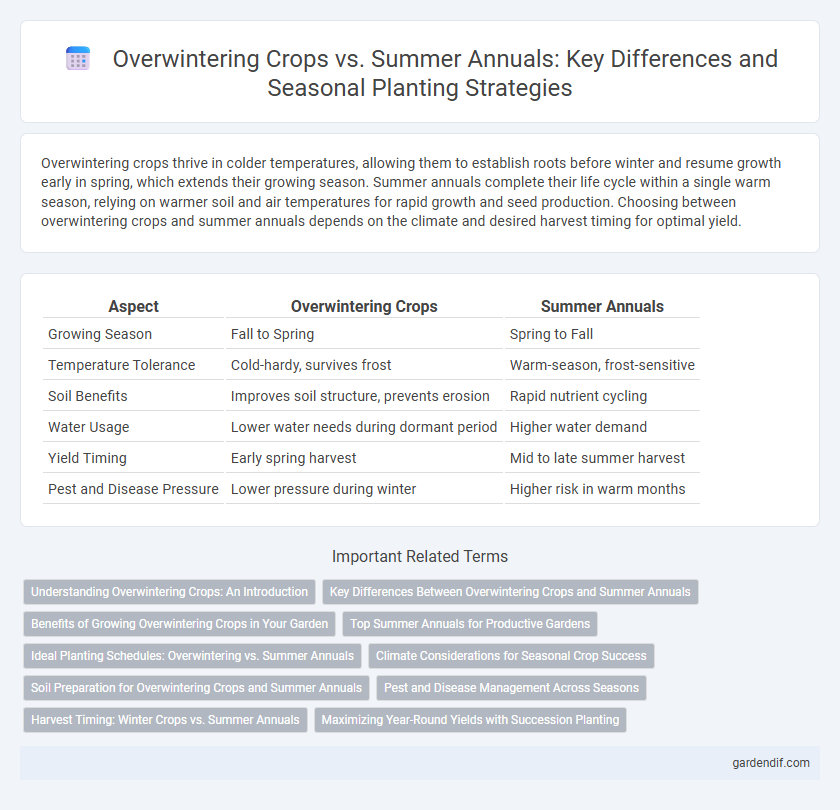
Overwintering crops vs Summer annuals Illustration
Overwintering crops thrive in colder temperatures, allowing them to establish roots before winter and resume growth early in spring, which extends their growing season. Summer annuals complete their life cycle within a single warm season, relying on warmer soil and air temperatures for rapid growth and seed production. Choosing between overwintering crops and summer annuals depends on the climate and desired harvest timing for optimal yield.
Table of Comparison
| Aspect | Overwintering Crops | Summer Annuals |
|---|---|---|
| Growing Season | Fall to Spring | Spring to Fall |
| Temperature Tolerance | Cold-hardy, survives frost | Warm-season, frost-sensitive |
| Soil Benefits | Improves soil structure, prevents erosion | Rapid nutrient cycling |
| Water Usage | Lower water needs during dormant period | Higher water demand |
| Yield Timing | Early spring harvest | Mid to late summer harvest |
| Pest and Disease Pressure | Lower pressure during winter | Higher risk in warm months |
Understanding Overwintering Crops: An Introduction
Overwintering crops are plants sown in the fall that survive through winter to resume growth in spring, providing early yields and enhancing soil health. Unlike summer annuals, which complete their lifecycle during warm months, overwintering crops develop cold tolerance, reducing erosion and nutrient loss. Key examples include winter wheat, rye, and certain forage crops, making them vital for sustainable crop rotation and extended growing seasons.
Key Differences Between Overwintering Crops and Summer Annuals
Overwintering crops, such as winter wheat and rye, are planted in the fall and mature in the spring, enduring cold temperatures and dormancy periods to complete their life cycle. Summer annuals like corn and soybeans are planted in spring or early summer, grow rapidly during warmer months, and produce a single harvest before the first frost. The key difference lies in their growth cycle timing and temperature tolerance, with overwintering crops adapted to survive frost and maintain soil cover during winter, while summer annuals optimize growth during the hot season.
Benefits of Growing Overwintering Crops in Your Garden
Overwintering crops enhance soil fertility by fixing nitrogen and preventing nutrient leaching during the cold months. These crops extend the growing season, providing early spring harvests and reducing pest pressure. Their deep root systems improve soil structure and water retention, promoting healthier, more resilient garden ecosystems.
Top Summer Annuals for Productive Gardens
Top summer annuals such as tomatoes, peppers, and cucumbers thrive in warm temperatures and long daylight hours, making them ideal for productive garden yields during the growing season. These crops require consistent watering, full sun exposure, and rich, well-drained soil to maximize fruit production and overall plant health. Selecting high-yield varieties and practicing proper spacing supports vigorous growth and optimizes garden productivity throughout summer.
Ideal Planting Schedules: Overwintering vs. Summer Annuals
Ideal planting schedules for overwintering crops typically fall in late summer to early fall, allowing these plants to establish roots before winter dormancy and resume growth in spring. Summer annuals thrive when sown in late spring after the last frost, maximizing warm-season conditions for rapid growth and harvest. Scheduling crops according to these seasonal windows optimizes yield and nutrient uptake by aligning plant life cycles with climate patterns.
Climate Considerations for Seasonal Crop Success
Overwintering crops, such as winter wheat and rye, thrive in cooler, frost-prone climates by entering dormancy and resuming growth in spring, optimizing water usage and soil nutrients during colder months. Summer annuals like corn and soybeans require warmer temperatures and longer daylight periods to complete their life cycle, making them ideal for regions with frost-free growing seasons. Climate considerations including temperature fluctuations, frost dates, and precipitation patterns are critical for selecting appropriate crops to maximize yield and ensure seasonal crop success.
Soil Preparation for Overwintering Crops and Summer Annuals
Soil preparation for overwintering crops requires deep tillage and organic matter incorporation to enhance soil structure and moisture retention during cold months. Summer annuals benefit from lighter tillage and timely fertilization to support rapid growth during warm seasons. Proper soil pH adjustment and nutrient balancing are critical for both crop types to optimize yield and crop health.
Pest and Disease Management Across Seasons
Overwintering crops provide a crucial habitat for beneficial insects but can also harbor pests and diseases that threaten early spring growth, necessitating vigilant monitoring and crop rotation to minimize pathogen carryover. Summer annuals, with their rapid growth and shorter life cycles, often require targeted pest management strategies such as timely insecticide applications and resistant cultivar selection to control infestations effectively during peak pest seasons. Integrated pest management practices that adapt to seasonal crop dynamics reduce reliance on chemical controls and enhance long-term field health.
Harvest Timing: Winter Crops vs. Summer Annuals
Winter crops are typically harvested in late fall or early spring, capitalizing on cool temperatures that enhance flavor and nutrient content. In contrast, summer annuals reach maturity by mid to late summer, benefiting from long daylight hours and warmer conditions that accelerate growth. Optimal harvest timing for each crop type depends on seasonal temperature patterns and crop-specific growth cycles to maximize yield and quality.
Maximizing Year-Round Yields with Succession Planting
Overwintering crops such as winter wheat and carrots endure cold temperatures, extending productivity into early spring and reducing offseason gaps. Summer annuals like tomatoes and cucumbers thrive in warm months, offering high yields during peak growing seasons. Implementing succession planting strategies with alternating overwintering crops and summer annuals maximizes year-round yields by continuously utilizing available growing periods and optimizing resource use.
Overwintering crops vs Summer annuals Infographic

 gardendif.com
gardendif.com